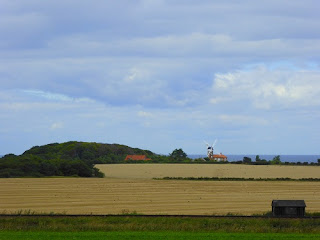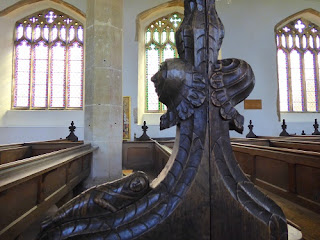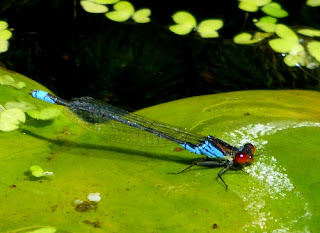Two Sundays ago, I was basking in the focused glory of the Latvian Radio Choir singing Rachmaninov's All-Night Vigil (Vespers) at a late-night Prom (photo courtesy BBC/Mark Allan; the rest apart from the Vereshchagin painting are mine or taken on my camera in the case of the Imperial College shot).
On the following Tuesday morning, by pure serendipity, I happened to be in Riga, where my wonderful Latvian friend Kristaps took me to see St John's Church in the Old Town, knowing it was where the choir had recorded the Rachmaninov.
That Sunday before I could take off to Latvia and one of my favourite places in the world, Pärnu in Estonia, was quite a bit of work. First I had to prepare for and then speak at the afternoon Proms Extra event in the Imperial College Union just down from the Royal Albert Hall. Here I am, below, with one of Radio 3's very best presenters, Louise Fryer, and my New Best Friend (we hadn't met before), Royal College of Music doyenne and Taneyev expert Anastasia Belina, a very vivacious person. You can hear an edited version of the talk in the interval of the BBC Radio 3 broadcast of the main orchestral concert, with introductory chants from the LRC, for a while at any rate here - the Proms Extra slot starts at around 1:00:27. The choir's late-night performance of the Vespers is here.
Then I very willingly attended both Rachmaninov Proms and wrote about them on The Arts Desk - though the review had to be pieced together en route for Riga. The full Baltic experience of basking once again in the amazing performances of the Estonian Festival Orchestra players, both collectively and in chamber music, is covered here.
Kristaps packed such a lot in to the three hours we had in Riga before taking the coach to Pärnu at lunchtime that I can't cover it all here - another post will be necessary for the famous street of Art Nouveau buildings where the small publishing house for which he works is based. But I think we can justify two religious edifices and two places with a connection to a very famous composer. Our first interior was that of the Russian Orthodox Cathedral of the Nativity, built between 1876 and 1883 at Alexander II's behest, two of its golden domes glittering through the trees here on a hot summer morning.
It became a Lutheran church during the German occupation of World War 1, and later a planetarium under the Soviets. Its lavish restoration was completed in 2000.
The faithful line up to kiss their favourite icons
and under this fresco of the Nativity,
painted by Vasily Vershchagin. There are two 19th century Russian artists of that name, and I hope it's the more significant one, if only for the stark contrast of his most famous image painted on the eastern battlefield.
I got quite 'bolshie' when ferociously asked by a headscarved lady not to photograph (I did so without flash, and saw no prohibitive signs): this is as close as I could get to a Pussy Riot act against the wretched Russian Orthodox Church of today, Putin's poodle and hijacked by a vicious leader.
Of course it's all impressive, but much more to my taste was the modest and more ancient artistry of St John's, founded by Dominicans in 1200 and taken over by the Lutherans in 1587.
Rebuilt several times, extensively so after a major fire in 1677, it retains its beautiful Gothic ceiling, the finest in Latvia.
Kristaps knew of my Wagner passion so he managed to get us into an apartment block on Brīvības iela which stands on the site of the young(er) composer's dwelling between 1838 and '39. Here he wrote Rienzi, which I have the dubious pleasure of declaring I've now witnessed live, or about half of it. The stained glass window dates from 1913
and there's a plaque plus a portrait in an alcove, too.
The present building is impressive, in any case, with its fine staircase.
Pushing it a bit for time before the coach (which we caught, eventually, but not at the coach station), K kindly detoured down Richard Wagner Street - all names undergo rigorous Latvian reworking -
to see the concert hall he frequented when it was an opera house, with its appropriate dragons. During his time in Riga, he staged five different operas and conducted another 20. In orchestral concerts he focused - no surprise - on Beethoven. There's more useful information on Wagner in Riga here.
The hall/theatre subsequently played host to other very distinguished figures (I leave you to make them out).
And so, speedily, back through the green belt and via the Opera House, to a scramble for the coach, which concerned my laid-back friends and taxi driver far less than it did me. But I'm a great admirer of the brinksmanship which wants to show the visitor as much as possible: I do it myself, much to certain folks' consternation.
Tuesday, 29 August 2017
Sunday, 27 August 2017
Very hilly, Sheringham
As opposed, of course, to 'very flat, Norfolk' - which, in the north-east, it is definitely not. The Holt/Cromer ridge, sloping down from wooded tops to fertile pasture and cliffs, was a plaything for local boy Humphrey Repton, 'humanising, as well as animating, beautiful scenery' with his landscaping, declaring it 'my most favourite work' - and that from a distinguished list of 200.
Our Sheringham Rundweg, taking in woods, cliffs, town, the beach where we swam and a fine country church, began at the National Trust car park. The classic view of the park and house was not to come until towards the end. We began by walking through central woodland with very tall trees - conifers, Spanish chestnuts, oaks and beeches, even the odd monkey puzzle tree.
Soon we were fringing the wood, with isolated clumps of trees in a clearer landscape
and then the coast,
looking towards Weybourne Windmill and the north sea.
Couples were sitting on benches waiting for the steam train to pass and complete a classic view, but since we pressed on, turning from east to south where you can just make out the wind turbines out at sea
past a traditional way of forest management,
some virgin beech leaves on a branch shooting out from a knotty clump
and down towards the sea past poppy-fringed fields,
we only saw the train looking back.
Then it was out on to the cliffs which make such a marked contrast on this part of the coast to the saltmarshes and dunes of the north-west. Swallows were shrieking and swooping in abundance
while the view back reveals a steady climb (the top photo shows where to, the highest point on the coast)
and I even saw a solitary puffball mushroom near the cliff edge.
Sheringham prides itself on clean beaches - what will happen when (if, inshallah) we leave the EU?
We walked back along the lower sea front to find a spot sheltered by a windbreaker from which Cally and I could launch out for the obligatory swim, the beach proper occupied only by black-headed gulls.
I liked the vibe of Sheringham, the attention to detail in the muralising of its sea walls
and on this cafe front - we'll let Ellie off her non-punctuation for the piquancy of the graphics. I had no idea that Einstein, fleeing Hitler in 1933, found shelter in Roughton on Cromer Heath.
There's even an excellent coffee shop for us townies, serving its own roast, and of course the best fish and chips (competition between three chippies within close vicinity is strong). The next stretch meant walking along a road for about a mile until we reached Old Sheringham, very discreet, with its church nicely set below the park ridge.
I may be pre-empting a future Norfolk churches walk - next one due, in two Saturdays' time, should take us further east along the coast if the weather's fine - but it's time for some bench ends. All Saints is big, light and airy, 'full of interesting things,' as Betjeman notes. Clearly I should have paid more attention to the rood screen, but I was seduced by details like this mermaid, close by the table near the door.
Further east, off the central aisle, are a cat with a kitten in its mouth,
a swaddled figure (whether baby or corpse is debated) beneath an unusual face
and various mythical beasts like this dragon.
The memorial to Abbot Upcher (died 1819), who commissioned Repton to landscape the estate, is by Bacon Junior and Samuel Manning. Thus Pevsner: 'Hanging monument of considerable size. White marble. A disconsolate woman lies over a broken column and a dead branch'.
Upcher, encourged by Repton to let the local people gather wood on the estate in part of an attempt to strike 'a happy medium between Licentious Equality and Oppressive Tyranny' (big deal, we shrug now, but it no doubt was then), also provided the handsome reservoir outside, dedicated prematurely to the 'year of peace' 1814,
and with a handsome flint-walled basin behind the facade
A short walk up a lane leads you back to National Trust land, the boldest sweep of Sheringham Park.
More puffballs here as we climbed the hill
and then a fine view, as Repton intended, from the Temple as featured in his Red Book but not actually completed in his lifetime (the present replica dates from 1975).
Sheringham Hall, now in private hands, faces inland. As the National Trust guide puts it, presumably paraphrasing before quoting Repton, 'a sea view might be pleasant in the Bay of Naples, but not in the harsh climate of the north Norfolk coast: "Can it ever rain in Paradise?" '
And then, into the woods again.
Back at base, the nice man in the National Trust shop helped me to identify two species which had intrigued us on Jill's new pond in Lower Southrepps: the iridescent thing spinning rapidly in circles was a whirligig beetle, and though I was familiar with this creature, good to have its exact, if obvious, title: red-eyed damselfly.
Not finished with north Norfolk yet - and we'll be back there for the big annual walk, which will merit a couple more churches to be featured here by way of canvassing for sponsorship.
Wednesday, 23 August 2017
No-one portrays Waugh better than Waugh
So it was time to be back on the Waugh path after a break following consecutive reading of the first seven novels (in between, I took my time to get through A L Kennedy's Serious Sweet, which was rewarding; more on that anon). I started with a rather unsatisfying biography by Philip Eade. It's entertaining enough, if not the racy read reviews claim, on the early years in a newly-developed Hampstead (a reminder that all suburbia was a building site once). Where I get stuck is in the endless focus on unrequited (or unwanted) romances with women after the early gay phase. The letters quoted on this subject are surprisingly dull, especially when they supplant much-needed detail on trips abroad. There comes a point where you actively dislike the man: his famous rudeness, his snobbery and cultivation of the aristocracy, the conservatism which seems so at odds with the often anarchic fantasy of the novels.
Towards the end it gets interesting again as the gulf between seeming and being opens up, and Waugh writes his most autobiographical novel, The Ordeal of Gilbert Pinfold, written in 1956/7 about a spell of madness four years earlier. I turned to that immediately, fascinated by what Eade cites as its exact reproduction of what happened to drugged-up Waugh on a disastrous sea journey. This is no mixture of fact and fiction, from what I understand of the correspondences between reality and the creation of 'Pinfold', a 50-year-old novelist at an odd juncture in his life. In fact Waugh himself confirms the exactness in a 1960 BBC Face to Face interview: the specific three minutes are to be found here and the full interview here.
The first chapter and a half ('Portrait of the artist in middle-age' and the start of 'Collapse of Elderly Party') features some of the most precisely-penned and unsparing self-revelation I've ever come across from a creative artist. The infuriating and yet often endearing codger that emerges from Eade's biography is ruthlessly and amusingly exposed:
His strongest tastes were negative. He abhorred plastics, Picasso, sunbathing, and jazz - everything in fact that had happened in his own lifetime*. The tiny kindling of charity which came to him through his religion sufficed only to temper his disgust and change it to boredom. There was a phrase in the thirties: 'It is later than you think', which was designed to cause uneasiness. It was never later than Mr Pinfold thought. At intervals during the day night he would look at his watch and learn with disappointment how little of his life was past, how much there was still ahead of him. He wished no one ill, but he looked at the world sub specie aeternitatis and he found it flat as a map; except when, rather often, personal annoyance intruded. Then he would come tumbling from his exalted point of observation. Shocked by a bad bottle of wine, an impertinent stranger, or a fault in syntax, his mind like a cinema camera trucked furiously forward to confront the offending object close-up with glaring lens; with the eyes of a drill sergeant inspecting an awkward squad, bulging with wrath that was half-facetious, and with half-simulated incredulity; like a drill sergeant he was absurd to many but to some rather formidable.
Once upon a time all this had been thought diverting, People quoted his pungent judgments and invented anecdotes of his audacity, which were recounted as 'typical Pinfolds', Now, he realized his singularity had lost some of its attraction for others, but he was too old a dog to learn new tricks.
What follows, by way of narrative, is rather odd and occasionally a bit tedious: just as dreams often seem interesting only to the subject, the hallucinations Pinfold/Waugh experiences/experienced on the ship bound for India are only fitfully gripping and not often funny, though they do throw light on his persecution mania and his fear that people see him as an old poof, a snob, a coward (Waugh was not the third, at least). The steering back to 'normality' is beautifully done, as is the brief portrait of his calm and sensible wife. A one-off, and Nicholas Lezard makes further fine observations in his Guardian review here.
Made me think of a similarly divided Englishman, Elgar, and the gulf between his squirearchical persona as another middle-class chap aspiring to be a nob and the turbulence of his symphonic music (the first and third movements of his Second Symphony and the symphonic poem Falstaff are perhaps the equivalent of Waugh's Pinfold madness).
*In above-linked review, it's interesting to learn that Waugh thought a Francis Bacon painting would be the best cover illustration for the novel.
Subscribe to:
Comments (Atom)

























































